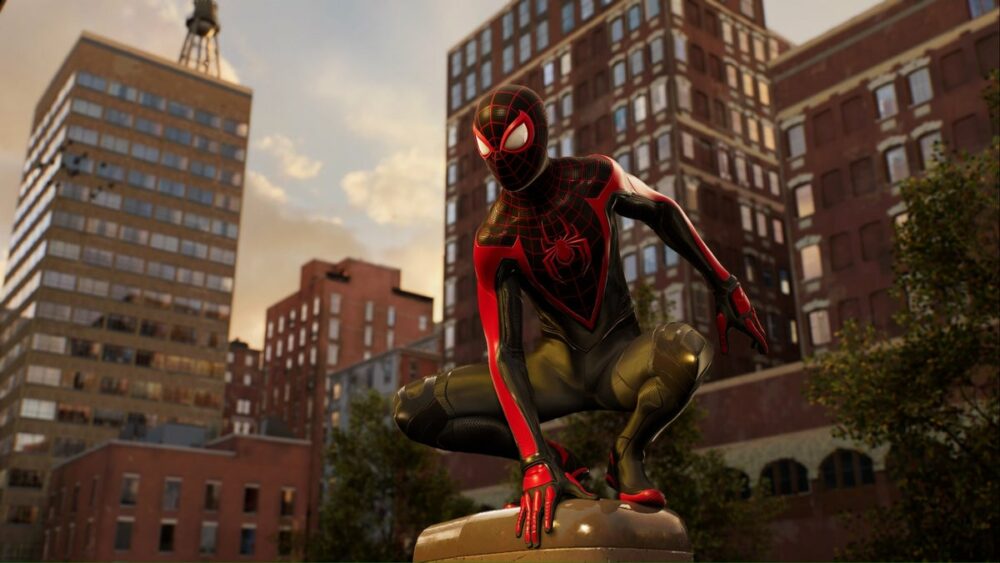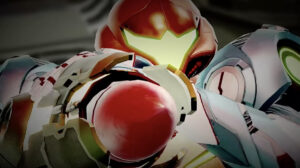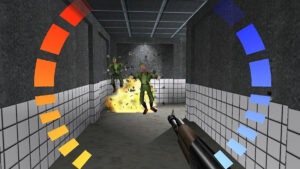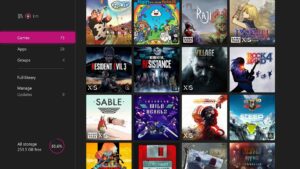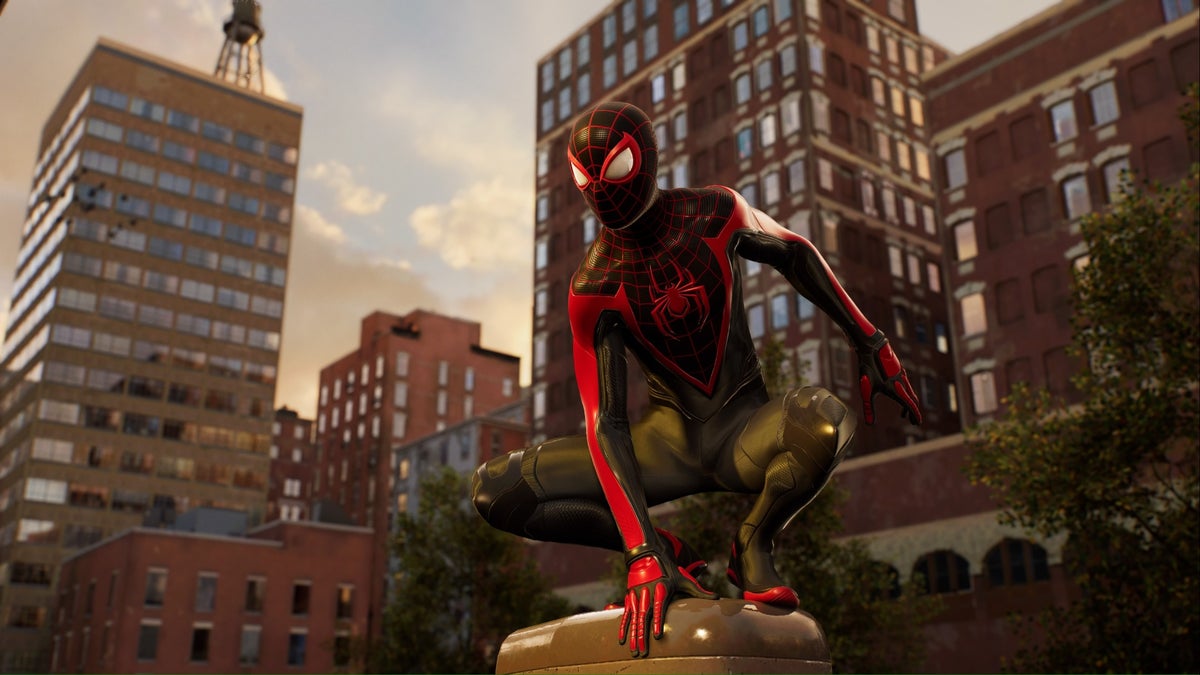
Insomniac’s Marvel’s Spider-Man 2 is a fantastic evolution of the formula set by the first two games in the series. Insomniac’s team has gifted us with another incredible Marvel sandbox to immerse ourselves in – Earth-1048, if you keep track of this stuff. As a whole this game is a wonderful sequel.
The narrative is everything I expected and more. It’s emotional in its exploration of both Peter Parker and Miles Morales dealing with the trauma of losing family members, and it covers their journeys to reach a healthier space without surrendering to the darkness inside. The enemy bosses are spectacular, especially the Sandman encounter at the beginning of the game, which sand-blasts you in the face with the power of the PS5. In general, the game’s boss fights reminded me of watching anime fight scenes: they’re fun and inventive but they’re all built around a core of powerful emotional context. Elsewhere, without spoiling too much, I thought Venom’s comic book history was remixed for the better, his tendrils slowly corrupting or affecting every major character. There’s forgiveness and redemption and a load of surprises. I can’t express the sheer artistry of what Insomniac has delivered.
In keeping with Insomniac’s recent work, Spider-Man 2’s also a more accessible experience than most blockbuster video games on the market – Bethesda’s Starfield, for example. However, while the accessibility features that are present are certainly helpful, if I’m being honest they’re not as good as I expected from this particular developer, and there’s a surprising omission of certain features – at the moment, at least. I would love to say that Insomniac has advanced accessibility even further here than it has in its previous games. Unfortunately, I can’t fully sing their praises in this regard. I gather many key accessibility settings will be added in the December update, so the game’s accessibility offering can only feel incomplete at launch. In its current state, Spider-Man 2 is simply not fully accessible, so many players will have to wait until the end of the year to thoroughly enjoy the experience.
Let’s dig into what is present. Things like game speed adjustments allow players to have more control of their experience with a simple button press. The ability to alter gameplay speed, reducing it to 70, 50 or 30 percent is extremely useful during web-swinging, combat or web-wing gliding, as it gives you enough time to alter your trajectory in wind tunnels or utilise movement abilities whilst airborne.
This matters because both traversal and combat have been reworked in brilliant new ways here. Building on the solid web-swinging foundation set by the previous games, the new web-wing traversal mechanic makes navigating between missions even more delightful than it was before. Swinging through New York feels joyously familiar, but the instant you start riding those wind tunnels, New York becomes fresh and even more exhilarating. Narratively I used the web-wings more when Peter or Miles were feeling stuck and required freedom to process or make difficult choices.
The new combat mechanics, meanwhile, utilise gadgets and Symbiote / Bio-Electric abilities more intuitively by holding down L1 or R1 and pressing one of the face buttons instead of making a selection with an immersion-breaking weapon wheel. Nowadays every game seems to require a parry button and Spider-Man 2 has listened loud and clear. The parry mechanic is another element improving combat encounters by sprinkling some tactical spice, dodge spamming is no longer the only answer to mitigate damage as some enemies can only be defeated with a parry attack.
This is all great. But when booting up the game and exploring the accessibility settings I was shocked by the lack of button remapping, which was available in Spider-Man: Miles Morales and is a standard in most PlayStation first-party titles. You can alter the controls from the system level, but in-game remapping is easier, more intuitive and tooltips will show your button setup correctly. Without control remapping my first impression of the game was tainted, so I struggled with the Sandman boss instead of marvelling at the sight of the coolest tutorial villain ever.
Moving on, the motor accessibility options are great, with options designed to assist gamers with limited movement, reduced strength and increased fatigue. You have options to turn every button hold into a toggle, enable web shooter burst-firing from a single press, dodge continuously by holding down the dodge button. There’s also enhanced auto-aim, the ability to increase the timing for successful dodges and parries, the ability to set quick-time events to auto-complete, attack by tapping, use one tap to execute a 4-hit combo or even attack continuously by holding down the attack button. However, without control remapping, options for toggles aren’t particularly helpful if the action isn’t placed on a button comfortable for you.
The option for auto healing is a great addition, eliminating a button press. However I have caveats here, sadly. The implementation is quite unhelpful, because the tutorial forces you to press the heal button to end the tutorial message, locking your progression. If you have options in place to remove a button press, then it’s best to alter the tutorial message instead of forcing players to press a button they already opted not to use. Tweaked accordingly, these settings have the potential to create a truly accessible experience, reaching the high level already set by Insomniac.
Elsewhere, the chase assist feature is beneficial as it slows down enemy movement whilst automating the QTE button press usually required during the moment you’re close enough to an enemy to capture them. It makes these sequences fun without a player’s reduced reaction time creating an unnecessary failure state ruining the superhero high. In comics, triangles aren’t Spider-Man’s arch villain, so why should those 3 pointed goons defeat him in games?
Finally, Spider-Man 2 has two shortcut buttons placed on the left and right D-Pad directions, which means you have the choice to assign several actions without pausing the game or fiddling with the settings menu. The actions that you can assign could be actions requiring multiple button presses, such as Web-throwing environmental items, several accessibility settings such as altering game speed or actions activated by touch-pad swipes such as opening the FNSM app.
I might sound negative about Spider-Man 2 but I must emphasise that it does have great accessible design overall, with helpful options catering for all types of gamers. It does merit praise. As I said at the top, It’s more accessible than many recent titles, but it’s not up to the standard already set so high by Insomniac as a studio. I know that Insomniac has a fantastic accessibility team that understands the importance of inclusion. This small step backwards is disappointing, but hopefully the accessibility omissions will be web-swinging to us soon in December alongside the eagerly anticipated release of the PlayStation Access Controller.
- SEO Powered Content & PR Distribution. Get Amplified Today.
- PlatoData.Network Vertical Generative Ai. Empower Yourself. Access Here.
- PlatoAiStream. Web3 Intelligence. Knowledge Amplified. Access Here.
- PlatoESG. Carbon, CleanTech, Energy, Environment, Solar, Waste Management. Access Here.
- PlatoHealth. Biotech and Clinical Trials Intelligence. Access Here.
- Source: https://www.eurogamer.net/marvels-spider-man-2s-accessibility-options-are-incomplete-at-present
- 30
- 50
- 7
- a
- abilities
- ability
- About
- access
- accessibility
- accessible
- accordingly
- Action
- actions
- added
- ADDITION
- adjustments
- advanced
- affecting
- All
- allow
- alongside
- already
- also
- an
- and
- anime
- Another
- answer
- anticipated
- app
- ARE
- around
- artistry
- as
- At
- attack
- auto
- available
- BE
- because
- becomes
- been
- before
- beginning
- being
- beneficial
- BEST
- Better
- between
- blockbuster
- book
- both
- brilliant
- Building
- built
- but
- button
- by
- CAN
- capture
- certain
- certainly
- character
- chase
- choice
- choices
- clear
- close
- combat
- content
- context
- continuously
- Control
- controller
- controls
- cookie
- cookies
- Core
- correctly
- could
- covers
- create
- Creating
- Current
- Current state
- damage
- dealing
- December
- delivered
- Design
- designed
- Developer
- difficult
- dig
- directions
- disappointing
- Dodge
- does
- down
- During
- eagerly
- easier
- element
- eliminating
- Emotional
- enable
- end
- enhanced
- enjoy
- enough
- environmental
- especially
- even
- events
- EVER
- Every
- everything
- evolution
- Example
- execute
- exhilarating
- expected
- experience
- exploration
- Exploring
- express
- extremely
- Face
- Failure
- familiar
- family
- family members
- fatigue
- Feature
- Features
- feel
- fight
- fights
- Finally
- First
- First Impression
- For
- forces
- forcing
- formula
- Foundation
- Freedom
- fresh
- from
- fully
- fun
- further
- Gadgets
- game
- gameplay
- Gamers
- Games
- gather
- GDPR
- General
- gives
- good
- great
- has
- Have
- healing
- helpful
- here
- High
- him
- his
- history
- hold
- holding
- honest
- Hopefully
- however
- HTTPS
- i
- if
- immerse
- implementation
- importance
- improving
- in
- in-game
- inclusion
- Increase
- increased
- incredible
- INSIDE
- instant
- instead
- into
- intuitive
- Is
- IT
- items
- ITS
- journeys
- jpg
- keep
- keeping
- Key
- know
- lack
- launch
- least
- left
- Level
- like
- Limited
- load
- longer
- losing
- LOUD
- love
- major
- make
- MAKES
- Making
- manage
- many
- Market
- Marvel
- Marvel's Spider-Man 2
- Marvel’s Spider-Man
- Matters
- me
- means
- Meanwhile
- Mechanics
- Members
- Message
- might
- missions
- mitigate
- moment
- more
- most
- movement
- moving
- much
- multiple
- must
- my
- narrative
- Navigating
- negative
- New
- New York
- no
- not
- of
- offering
- on
- One
- only
- opening
- Option
- Options
- or
- ourselves
- overall
- particular
- particularly
- pausing
- percent
- peter
- place
- plato
- plato data intelligence
- platodata
- platogaming
- players
- playstation
- please
- potential
- power
- powerful
- present
- press
- pressing
- previous
- Process
- progression
- ps5
- quite
- reach
- reaching
- reaction
- recent
- redemption
- Reduced
- reducing
- regard
- release
- remove
- require
- required
- reveal
- review
- right
- s
- Said
- sandbox
- say
- scenes
- see
- seems
- selection
- sequel
- Series
- set
- settings
- setup
- several
- shocked
- Shooter
- should
- show
- sight
- Simple
- Simply
- single
- small
- So
- solid
- some
- Soon
- sound
- Space
- speed
- spice
- spider-man
- Spider-Man 2
- Spider-Man: Miles Morales
- standard
- Starfield
- start
- State
- step
- strength
- studio
- successful
- such
- superhero
- surprises
- surprising
- Swipes
- system
- tactical
- Tap
- tapping
- targeting
- Team
- than
- that
- The
- The Game
- the sandman
- their
- Them
- then
- These
- they
- things
- this
- those
- thought
- Through
- time
- timing
- titles
- to
- too
- top
- track
- trailer
- trajectory
- truly
- turn
- tutorial
- two
- types
- understands
- unfortunately
- unnecessary
- until
- up
- Update
- us
- use
- used
- usually
- Video
- video games
- wait
- was
- watching
- ways
- web
- were
- What
- What is
- Wheel
- when
- while
- whole
- why
- will
- wind
- window
- with
- without
- Work
- would
- year
- york
- you
- your
- youtube
- zephyrnet
